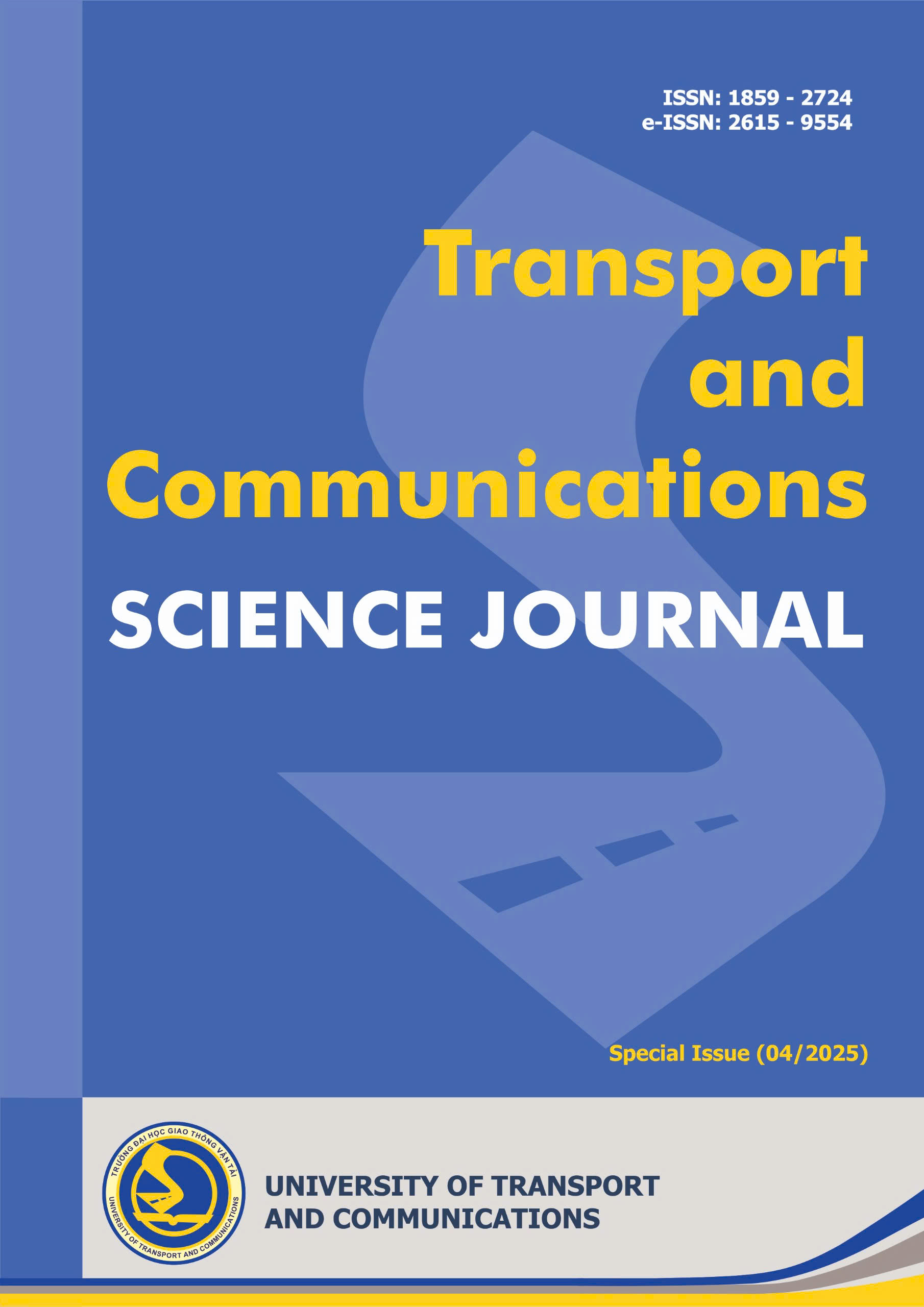Effectiveness study on the wind barriers of the HSR bridges in wind prone region
Email:
btthanh@utc.edu.vn
Từ khóa:
High-speed railway, numerical simulation, simply-supported bridge, running safety, wind barrier
Tóm tắt
In areas frequently affected by strong winds, high-speed railway (HSR) bridges are commonly equipped with wind barriers to ensure train operational safety. This study focuses on a multi-span simply supported prestressed concrete bridge located along a real HSR line in Western China. Different barrier configurations with varying heights and porosities are investigated. A comprehensive wind-train-bridge interaction dynamic model is established to simulate the system's response, incorporating the effects of fluctuating crosswind velocities. Temporal histories of dynamic responses from both the train and the bridge are calculated and analyzed. A comparative evaluation of various barrier designs is conducted to determine their effectiveness in mitigating adverse wind effects. The results indicate that a barrier with a total height of 3.5 meters, consisting of 10% porosity in the lower 1.0 meter and 20% porosity in the upper 2.5 meters, provides the best performance in balancing wind shielding and structural stability. This research offers valuable insights for optimizing the design of wind barriers on HSR bridges in high-wind regionsTài liệu tham khảo
[1]. X. H. He, Recent developments in the wind resistance of railway bridges in China, Advances in Wind Engineering, 1 (2024) 100027. https://doi.org/10.1016/j.awe.2024.100027
[2]. J. F. Mao, A Novel Hybrid Approach Combining PDEM and Bayesian Optimization Deep Learning for Stochastic Vibration Analysis in Train-Track-Bridge Coupled System, Reliability Engineering and System Safety, 257 (2025) 110827. https://doi.org/10.1016/j.ress.2025.110827
[3]. R. K. Cooper, The effect of cross winds on trains, Journal of Fluids Engineering, 103 (1981) 170-178. https://doi.org/10.1115/1.3240768
[4]. H. Hassan, Contribution of computational wind engineering in train aerodynamics—past and future. Journal of Wind Engineering and Industrial Aerodynamics, 234 (2023) 105352. https://doi.org/10.1016/j.jweia.2023.105352
[5]. Y. L. Li, Dynamics of wind-rail vehicle-bridge systems, Journal of Wind Engineering and Industrial Aerodynamics, 93 (2005) 483-507. https://doi.org/10.1016/j.jweia.2005.04.001
[6]. Z. W. Xu, G. L. Dai, Y. F. Chen, H. M. Rao, Z. B. Huang, Extreme response analysis of train-track-bridge-wind interaction system based on in-situ monitoring wind data, Structural Safety, 100 (2023) 102288. https://doi.org/10.1016/j.strusafe.2022.102288
[7]. Y. L. Xu, N. Zhang, H. Xia, Vibration of coupled train and cable-stayed bridge system in cross wind”, Engineering Structure, 26 (2004) 1389-1406. https://doi.org/10.1016/j.engstruct.2004.05.005
[8]. T. Fujii, T. Maeda, H. Ishida, T. Imai, K. Tanemoto, M. Suzuki, Wind-induced accidents of train/vehicles and their measures in Japan, Quarterly Report of RTRI, 40 (1999) 50-55.
[9]. B. D. Xiong, Sustainable wind barrier: Self-powered system for high-speed railway safety monitoring, Sustainable Materials and Technologies, 39 (2024) e00848.
[10]. W. W. Guo, H. Xia, R. Karoumi, T. Zhang, X. Z. Li, Aerodynamic effect of wind barriers and running safety of trains on high-speed railway bridges under cross winds, Wind and Structures, 20 (2015) 213-236. https://doi.org/10.12989/was.2015.20.2.213
[11]. X. Z. Li, Y. X. Zhou, M. Wang, Aerodynamic Interference and Dynamic Influence of Wind Barrier on Train-bridge Coupling Vibration, KSCE Journal of Civil Engineering System, 21 (2023) 3036-3047. https://doi.org/10.1007/s12205-023-1884-0
[12]. E. Lopez-Nuñez, Effect of wind barriers on the aeroelastic instabilities of a hinged-deck cross-section cable-stayed bridge, Engineering Structures, 287 (2023) 116112, https://doi.org/10.1016/j.engstruct.2023.116112
[13]. M. Wang, Z. X. Wang, X. W. Qiu, X. X. Li, X. Z. Li, Windproof performance of wind barrier on the aerodynamic characteristics of high-speed train running on a simple supported bridge, Journal of Wind Engineering and Industrial Aerodynamics, 223 (2022) 104950. https://doi.org/ 10.1016/j.jweia.2022.104950
[14]. D. Q. Zhang, H. X. Gao, W. J. Jiang, X. H. Dong, J. Song, G. Hu, Mitigating crosswind response of a high-speed train passing the end of windbreak walls, Advances in Wind Engineering, 1 (2024) 100009. https://doi.org/10.1016/j.awe.2024.100009
[15]. H. Xia, Y.L. Xu, T. H. T. Chan, Dynamic interaction of long suspension bridges with running trains, Journal of Sound and Vibration, 237 (2000) 263-280. https://doi.org/10.1006/jsvi.2000.3027
[16]. H. Xia, D. R. Guido, J. M. Goicolea, Bridge Vibration and Controls: New Research, Nova Science Publishers, New York, 2012.
[17]. Y. H. Cao, H. F. Xiang Haifan, Y. Zhou, Simulation of stochastic wind velocity field on long-span bridges, Journal of Engineering Mechanics, 126 (2000) 1-6, https://doi.org/10.1061/(ASCE)0733-9399(2000)126:1(1)
[18]. E. Simiu, R. H. Scanlan Robert, Wind Effects on Structures: Fundamentals and Applications to Design, Wiley Publishing, New York, 1996.
[19]. W. W. Guo, H. Xia, Y. L. Xu, Running safety analysis of a train on the Tsing Ma bridge under turbulent winds, Earthquake Engineering and Engineering Vibration, 9 (2010) 307-318. https://doi.org/10.1007/s11803-010-0015-3
[20]. K. Liu, E.Reynders, G. De Roeck, G. Lombaert, Experimental and numerical analysis of a composite bridge for high-speed trains, Journal of Sound Vibration, 320 (2009) 201-220.
[21]. P. Lou, A vehicle-track-bridge interaction element considering vehicle’s pitching effect, Finite Elements in Analysis and Design, 4 (2005) 397-427.
[22]. M. X. Chen, L. Wang, X. X. Tao, G. H. Cui, X. S. Chai, F. C. Yang, W. Q. Wu. Fitting method of track spectrum for main line railway in China (in Chinese), Journal of Traffic and Transportation Engineering, 8 (2008) 19-22. https://doi.org/10.3321/j.issn:1671-1637.2008.01.005
[23]. MINISTRY OF TRANSPORT OF P. R. C., Wind-resistant Design Specification for Highway Bridges (JTGT3360-01-2018), People's Communications Publishing House Co., Ltd, Beijing (in Chinese), Mar. 2019.
[24]. W. W. Guo, Y. J. Wang, H. Xia, S. Lu, Wind tunnel test on aerodynamic effect of wind barriers on train-bridge system, Science China Technological Sciences, 58 (2015) 219-225.
[25]. NATIONAL RAILWAY ADMINISTRATION OF P. R. C., Code for design of high-speed railway (TB 10621-2014), China Railway Publishing House, Beijing (in Chinese), Dec. 2014.
[2]. J. F. Mao, A Novel Hybrid Approach Combining PDEM and Bayesian Optimization Deep Learning for Stochastic Vibration Analysis in Train-Track-Bridge Coupled System, Reliability Engineering and System Safety, 257 (2025) 110827. https://doi.org/10.1016/j.ress.2025.110827
[3]. R. K. Cooper, The effect of cross winds on trains, Journal of Fluids Engineering, 103 (1981) 170-178. https://doi.org/10.1115/1.3240768
[4]. H. Hassan, Contribution of computational wind engineering in train aerodynamics—past and future. Journal of Wind Engineering and Industrial Aerodynamics, 234 (2023) 105352. https://doi.org/10.1016/j.jweia.2023.105352
[5]. Y. L. Li, Dynamics of wind-rail vehicle-bridge systems, Journal of Wind Engineering and Industrial Aerodynamics, 93 (2005) 483-507. https://doi.org/10.1016/j.jweia.2005.04.001
[6]. Z. W. Xu, G. L. Dai, Y. F. Chen, H. M. Rao, Z. B. Huang, Extreme response analysis of train-track-bridge-wind interaction system based on in-situ monitoring wind data, Structural Safety, 100 (2023) 102288. https://doi.org/10.1016/j.strusafe.2022.102288
[7]. Y. L. Xu, N. Zhang, H. Xia, Vibration of coupled train and cable-stayed bridge system in cross wind”, Engineering Structure, 26 (2004) 1389-1406. https://doi.org/10.1016/j.engstruct.2004.05.005
[8]. T. Fujii, T. Maeda, H. Ishida, T. Imai, K. Tanemoto, M. Suzuki, Wind-induced accidents of train/vehicles and their measures in Japan, Quarterly Report of RTRI, 40 (1999) 50-55.
[9]. B. D. Xiong, Sustainable wind barrier: Self-powered system for high-speed railway safety monitoring, Sustainable Materials and Technologies, 39 (2024) e00848.
[10]. W. W. Guo, H. Xia, R. Karoumi, T. Zhang, X. Z. Li, Aerodynamic effect of wind barriers and running safety of trains on high-speed railway bridges under cross winds, Wind and Structures, 20 (2015) 213-236. https://doi.org/10.12989/was.2015.20.2.213
[11]. X. Z. Li, Y. X. Zhou, M. Wang, Aerodynamic Interference and Dynamic Influence of Wind Barrier on Train-bridge Coupling Vibration, KSCE Journal of Civil Engineering System, 21 (2023) 3036-3047. https://doi.org/10.1007/s12205-023-1884-0
[12]. E. Lopez-Nuñez, Effect of wind barriers on the aeroelastic instabilities of a hinged-deck cross-section cable-stayed bridge, Engineering Structures, 287 (2023) 116112, https://doi.org/10.1016/j.engstruct.2023.116112
[13]. M. Wang, Z. X. Wang, X. W. Qiu, X. X. Li, X. Z. Li, Windproof performance of wind barrier on the aerodynamic characteristics of high-speed train running on a simple supported bridge, Journal of Wind Engineering and Industrial Aerodynamics, 223 (2022) 104950. https://doi.org/ 10.1016/j.jweia.2022.104950
[14]. D. Q. Zhang, H. X. Gao, W. J. Jiang, X. H. Dong, J. Song, G. Hu, Mitigating crosswind response of a high-speed train passing the end of windbreak walls, Advances in Wind Engineering, 1 (2024) 100009. https://doi.org/10.1016/j.awe.2024.100009
[15]. H. Xia, Y.L. Xu, T. H. T. Chan, Dynamic interaction of long suspension bridges with running trains, Journal of Sound and Vibration, 237 (2000) 263-280. https://doi.org/10.1006/jsvi.2000.3027
[16]. H. Xia, D. R. Guido, J. M. Goicolea, Bridge Vibration and Controls: New Research, Nova Science Publishers, New York, 2012.
[17]. Y. H. Cao, H. F. Xiang Haifan, Y. Zhou, Simulation of stochastic wind velocity field on long-span bridges, Journal of Engineering Mechanics, 126 (2000) 1-6, https://doi.org/10.1061/(ASCE)0733-9399(2000)126:1(1)
[18]. E. Simiu, R. H. Scanlan Robert, Wind Effects on Structures: Fundamentals and Applications to Design, Wiley Publishing, New York, 1996.
[19]. W. W. Guo, H. Xia, Y. L. Xu, Running safety analysis of a train on the Tsing Ma bridge under turbulent winds, Earthquake Engineering and Engineering Vibration, 9 (2010) 307-318. https://doi.org/10.1007/s11803-010-0015-3
[20]. K. Liu, E.Reynders, G. De Roeck, G. Lombaert, Experimental and numerical analysis of a composite bridge for high-speed trains, Journal of Sound Vibration, 320 (2009) 201-220.
[21]. P. Lou, A vehicle-track-bridge interaction element considering vehicle’s pitching effect, Finite Elements in Analysis and Design, 4 (2005) 397-427.
[22]. M. X. Chen, L. Wang, X. X. Tao, G. H. Cui, X. S. Chai, F. C. Yang, W. Q. Wu. Fitting method of track spectrum for main line railway in China (in Chinese), Journal of Traffic and Transportation Engineering, 8 (2008) 19-22. https://doi.org/10.3321/j.issn:1671-1637.2008.01.005
[23]. MINISTRY OF TRANSPORT OF P. R. C., Wind-resistant Design Specification for Highway Bridges (JTGT3360-01-2018), People's Communications Publishing House Co., Ltd, Beijing (in Chinese), Mar. 2019.
[24]. W. W. Guo, Y. J. Wang, H. Xia, S. Lu, Wind tunnel test on aerodynamic effect of wind barriers on train-bridge system, Science China Technological Sciences, 58 (2015) 219-225.
[25]. NATIONAL RAILWAY ADMINISTRATION OF P. R. C., Code for design of high-speed railway (TB 10621-2014), China Railway Publishing House, Beijing (in Chinese), Dec. 2014.
Tải xuống
Chưa có dữ liệu thống kê

Nhận bài
03/03/2025
Nhận bài sửa
21/04/2025
Chấp nhận đăng
28/04/2025
Xuất bản
30/04/2025
Chuyên mục
Công trình khoa học
Kiểu trích dẫn
Guo Wei, W., Xia Chao, Y., & Bui Tien, T. (1745946000). Effectiveness study on the wind barriers of the HSR bridges in wind prone region. Tạp Chí Khoa Học Giao Thông Vận Tải, 76(2025), 432-446. https://doi.org/10.47869/tcsj.76.2025.6
Số lần xem tóm tắt
105
Số lần xem bài báo
49









